A Coordination Polymer of Dy(III) with Polycarboxylic Acid Ligand: Synthesis, Characterization and Magnetic Properties
Abstract
1. Introduction
2. Materials and Methods
2.1. Materials
2.2. Synthesis of [DyLH2O]n (1)
2.3. X-Ray Crystallography
2.4. Fourier-Transform Infrared Spectroscopy (FT-IR)
2.5. Thermogravimetric Analysis (TG)
2.6. Elemental Analysis
2.7. Powder X-Ray Diffraction (PXRD)
2.8. Magnetic Measurements
3. Results and Discussion
3.1. Crystal Structure
3.2. PXRD and TG Analysis
3.3. Magnetic Properties
4. Conclusions
Supplementary Materials
Author Contributions
Funding
Data Availability Statement
Conflicts of Interest
References
- Wang, X.X.; Yue, L.L.; Zhou, P.; Fan, L.H.; He, Y.B. Lanthanide–Organic Frameworks Featuring Three-Dimensional Inorganic Connectivity for Multipurpose Hydrocarbon Separation. Inorg. Chem. 2021, 60, 17249–17257. [Google Scholar] [CrossRef] [PubMed]
- Wang, X.; Ma, F.Y.; Xiong, S.S.; Bai, Z.L.; Zhang, Y.G.; Li, G.D.; Chen, J.C.; Yuan, M.J.; Wang, Y.L.; Dai, X.; et al. Efficient Xe/Kr Separation Based on a Lanthanide-Organic Framework with One-Dimensional Local Positively Charged Rhomboid Channels. ACS Appl. Mater. Interfaces 2022, 14, 22233–22241. [Google Scholar] [CrossRef]
- Zhang, X.J.; Vieru, V.; Feng, X.W.; Liu, J.L.; Zhang, Z.J.; Na, B.; Shi, W.; Wang, B.W.; Powell, A.K.; Chibotaru, L.F.; et al. Influence of Guest Exchange on the Magnetization Dynamics of Dilanthanide Single-Molecule-Magnet Nodes within a Metal–Organic Framework. Angew. Chem. Int. Ed. 2015, 54, 9861–9865. [Google Scholar] [CrossRef]
- Wu, S.Y.; Lin, Y.N.; Liu, J.W.; Shi, W.; Yang, G.M.; Cheng, P. Rapid Detection of the Biomarkers for Carcinoid Tumors by a Water Stable Luminescent Lanthanide Metal–Organic Framework Sensor. Adv. Funct. Mater. 2018, 28, 1707169. [Google Scholar] [CrossRef]
- Echenique-Errandonea, E.; Mendes, R.F.; Figueira, F.; Choquesillo-Lazarte, D.; Beobide, G.; Cepeda, J.; Ananias, D.; Rodríguez-Diéguez, A.; Paz, F.A.A.; Seco, J.M. Multifunctional Lanthanide-Based Metal-Organic Frameworks Derived from 3-Amino-4-hydroxybenzoate: Single-Molecule Magnet Behavior, Luminescent Properties for Thermometry, and CO2 Adsorptive Capacity. Inorg. Chem. 2022, 61, 12977–12990. [Google Scholar] [CrossRef]
- Sahoo, J.; Arunachalam, R.; Subramanian, P.S.; Suresh, E.; Valkonen, A.; Rissanen, K.; Albrecht, M. Coordinatively Unsaturated Lanthanide(III) Helicates: Luminescence Sensors for Adenosine Monophosphate in Aqueous Media. Angew. Chem. Int. Ed. 2016, 55, 9625–9629. [Google Scholar] [CrossRef] [PubMed]
- Wang, X.Q.; Zhang, L.L.; Yang, J.; Liu, F.L.; Dai, F.; Wang, R.M.; Sun, D.F. Lanthanide metal–organic frameworks containing a novel flexible ligand for luminescence sensing of small organic molecules and selective adsorption. J. Mater. Chem. A 2015, 3, 12777–12785. [Google Scholar] [CrossRef]
- Zhao, T.H.; Han, J.L.; Jin, X.; Liu, Y.; Liu, M.H.; Duan, P.F. Enhanced Circularly Polarized Luminescence from Reorganized Chiral Emitters on the Skeleton of a Zeolitic Imidazolate Framework. Angew. Chem. Int. Ed. 2019, 58, 4978–4982. [Google Scholar] [CrossRef] [PubMed]
- Senkovska, I.; Bon, V.; Abylgazina, L.; Mendt, M.; Berger, J.; Kieslich, G.; Petkov, P.; Fiorio, J.L.; Joswig, J.O.; Schaper, L.; et al. Understanding MOF Flexibility: An Analysis Focused on Pillared Layer MOFs as a Model System. Angew. Chem. Int. Ed. 2023, 62, e202218076. [Google Scholar] [CrossRef]
- Seth, S.; Savitha, G.; Moorthy, J.N. Diverse isostructural MOFs by postsynthetic metal node metathesis: Anionic-to-cationic framework conversion, luminescence and separation of dyes. J. Mater. Chem. A 2015, 3, 22915–22922. [Google Scholar] [CrossRef]
- Leoi, M.W.N.; Zheng, X.T.; Yu, Y.; Gao, J.J.; Ong, D.H.S.; Koh, C.Z.H.; Chen, P.; Yang, L. Redefining Metal Organic Frameworks in Biosensors: Where Are We Now? ACS Appl. Mater. Interfaces 2025, 17, 13246–13278. [Google Scholar] [CrossRef]
- Meng, S.Y.; Li, G.; Wang, P.; He, M.; Sun, X.H.; Li, Z.X. Rare earth-based MOFs for photo/electrocatalysis. Mater. Chem. Front. 2023, 7, 806–827. [Google Scholar] [CrossRef]
- Allain, C.; Faulkner, S. Photophysical Approaches to Responsive Optical Probes. Future Med. Chem. 2010, 2, 339–350. [Google Scholar] [CrossRef] [PubMed]
- Li, C.L.; Pang, Y.D.; Xu, Y.L.; Lu, M.J.; Tu, L.; Li, Q.; Sharma, A.; Guo, Z.Z.; Li, X.Y.; Sun, Y. Near-infrared metal agents assisting precision medicine: From strategic design to bioimaging and therapeutic applications. Chem. Soc. Rev. 2023, 52, 4392–4442. [Google Scholar] [CrossRef] [PubMed]
- Wei, S.X.; Li, Z.; Lu, W.; Liu, H.; Zhang, J.W.; Chen, T.; Tang, B.Z. Multicolor Fluorescent Polymeric Hydrogels. Angew. Chem. Int. Ed. 2020, 60, 8608–8624. [Google Scholar] [CrossRef]
- Krishnaraj, C.; Kaczmarek, A.M.; Jena, H.S.; Leus, K.; Chaoui, N.; Schmidt, J.; Deun, R.V.; Voort, P.V.D. Triggering White-Light Emission in a 2D Imine Covalent Organic Framework Through Lanthanide Augmentation. ACS Appl. Mater. Interfaces 2019, 11, 27343–27352. [Google Scholar] [CrossRef] [PubMed]
- Hao, J.N.; Niu, D.C.; Gu, J.L.; Lin, S.L.; Li, Y.S.; Shi, J.L. Structure Engineering of a Lanthanide-Based Metal–Organic Framework for the Regulation of Dynamic Ranges and Sensitivities for Pheochromocytoma Diagnosis. Adv. Mater. 2020, 32, 2000791. [Google Scholar] [CrossRef]
- Carlos, L.D.; Ferreira, R.A.S.; Bermudez, V.S.; Lopez, B.J.; Escribano, P. Progress on lanthanide-based organic–inorganic hybrid phosphors. Chem. Soc. Rev. 2011, 40, 536–549. [Google Scholar] [CrossRef]
- Yang, Y.W.; Su, P.R.; Tang, Y. Stimuli-Responsive Lanthanide-Based Smart Luminescent Materials for Optical Encoding and Bio-applications. ChemNanoMat 2018, 4, 1097–1120. [Google Scholar] [CrossRef]
- Pan, M.; Liao, W.M.; Yin, S.Y.; Sun, S.S.; Su, C.Y. Single-Phase White-Light-Emitting and Photoluminescent Color-Tuning Coordination Assemblies. Chem. Rev. 2018, 118, 8889–8935. [Google Scholar] [CrossRef]
- Thorarinsdottir, A.E.; David Harris, T. Metal–Organic Framework Magnets. Chem. Rev. 2020, 120, 8716–8789. [Google Scholar] [CrossRef] [PubMed]
- Layfield, R.A.; Murugesu, M. Lanthanides and Actinides in Molecular Magnetism; Wiley-VCH: Weinheim, Germany, 2015. [Google Scholar] [CrossRef]
- Bartolomé, E.; Arauzo, A.; Luzón, J.; Bartolomé, J.; Bartolom, É.F. Chapter 1—Magnetic Relaxation of Lanthanide-Based Molecular Magnets. In Handbook of Magnetic Materials; Brück, E., Ed.; Elsevier: Amsterdam, The Netherlands, 2017; pp. 1–289. [Google Scholar] [CrossRef]
- Ishikawa, N.; Sugita, M.; Ishikawa, T.; Koshihara, S.Y.; Kaizu, Y. Lanthanide Double-Decker Complexes Functioning as Magnets at the Single-Molecular Level. J. Am. Chem. Soc. 2003, 125, 8694–8695. [Google Scholar] [CrossRef]
- Zhang, P.; Guo, Y.N.; Tang, J.K. Recent advances in dysprosium-based single molecule magnets: Structural overview and synthetic strategies. Coord. Chem. Rev. 2013, 257, 1728–1763. [Google Scholar] [CrossRef]
- Wang, W.M.; Wang, S.Y.; Cui, J.Z.; Zhao, B. Modulating single-molecule magnet behaviour of phenoxo-O bridged lanthanide(III) dinuclear complexes by using different β-diketonate coligands. Inorg. Chem. Front. 2016, 3, 133–141. [Google Scholar] [CrossRef]
- Krylov, D.S.; Liu, F.; Avdoshenko, S.M.; Spree, L.; Weise, B.; Waske, A.; Wolter, A.U.B.; Buchner, B.; Popov, A.A. Record-high thermal barrier of the relaxation of magnetization in the nitride clusterfullerene Dy2ScN@C80-Ih. Chem. Commun. 2017, 53, 7901–7904. [Google Scholar] [CrossRef]
- Guo, F.S.; Day, B.M.; Chen, Y.C.; Tong, M.L.; Mansikkamäki, A.; Layfield, R.A. Magnetic hysteresis up to 80 kelvin in a dysprosium metallocene single-molecule magnet. Science 2018, 362, 1400–1403. [Google Scholar] [CrossRef]
- Zhang, J.; Wu, T.; Chen, S.M.; Feng, P.Y.; Bu, X.H. Versatile Structure-Directing Roles of Deep-Eutectic Solvents and Their Implication in the Generation of Porosity and Open Metal Sites for Gas Storage. Angew. Chem. Int. Ed. 2009, 48, 3486–3490. [Google Scholar] [CrossRef] [PubMed]
- Wei, Y.; Sa, R.; Wu, K. A highly stable and white-light-emitting Eu(III) MOF. Dalton Trans. 2016, 45, 18661–18667. [Google Scholar] [CrossRef]
- Gu, Z.G.; Chen, Z.; Fu, W.Q.; Wang, F.; Zhang, J. Liquid-Phase Epitaxy Effective Encapsulation of Lanthanide Coordination Compounds into MOF Film with Homogeneous and Tunable White-Light Emission. ACS Appl. Mater. Interfaces 2015, 7, 28585–28590. [Google Scholar] [CrossRef]
- Du, B.B.; Zhu, Y.X.; Pan, M.; Yue, M.Q.; Hou, Y.J.; Wu, K.; Zhang, L.Y.; Chen, L.; Yin, S.Y.; Fan, Y.N.; et al. Direct white-light and a dual-channel barcode module from Pr(iii)-MOF crystals. Chem. Commun. 2015, 51, 12533–12536. [Google Scholar] [CrossRef]
- Dong, J.; Zhao, D.; Lu, Y.; Sun, W.Y. Photoluminescent metal–organic frameworks and their application for sensing biomolecules. J. Mater. Chem. A 2019, 7, 22744–22767. [Google Scholar] [CrossRef]
- Tang, Q.; Liu, S.; Liu, Y.; He, D.; Miao, J.; Wang, X.; Ji, Y.; Zheng, Z. Color Tuning and White Light Emission via in Situ Doping of Luminescent Lanthanide Metal–Organic Frameworks. Inorg. Chem. 2014, 53, 289–293. [Google Scholar] [CrossRef] [PubMed]
- Wang, Z.X.; Wu, Q.F.; Liu, H.J.; Shao, M.; Xiao, H.P.; Li, M.X. 2D and 3D lanthanide coordination polymers constructed from benzimidazole-5,6-dicarboxylic acid and sulfate bridged secondary building units. CrystEngComm 2010, 12, 1139–1146. [Google Scholar] [CrossRef]
- Lu, W.G.; Jiang, L.; Lu, T.B. Lanthanide Contraction and Temperature-Dependent Structures of Lanthanide Coordination Polymers with Imidazole-4,5-Dicarboxylate and Oxalate. Cryst. Growth Des. 2010, 10, 4310–4318. [Google Scholar] [CrossRef]
- Zhan, C.H.; Wang, F.; Kang, Y.; Zhang, J. Lanthanide-Thiophene-2,5-dicarboxylate Frameworks: Ionothermal Synthesis, Helical Structures, Photoluminescent Properties, and Single-Crystal-to-Single-Crystal Guest Exchange. Inorg. Chem. 2012, 51, 523–530. [Google Scholar] [CrossRef]
- Liu, M.L.; Shi, Q.; Liu, L.F.; Li, W.B. Lanthanide-Aromatic Iminodiacetate Frameworks with Helical Tubes: Structure, Properties, and Low-Temperature Heat Capacity. ACS Omega 2021, 6, 10475–10485. [Google Scholar] [CrossRef] [PubMed]
- Lymperopoulou, S.; Papastergiou, M.; Louloudi, M.; Raptopoulou, C.; Psycharis, V.; Milios, C.J.; Plakatouras, J.C. Synthesis, Characterization, Magnetic and Catalytic Properties of a Ladder-Shaped MnII Coordination Polymer. Eur. J. Inorg. Chem. 2014, 2014, 3638–3644. [Google Scholar] [CrossRef]
- Liu, M.L.; Shi, W.; Song, H.B.; Cheng, P.; Liao, D.Z.; Yan, S.P. Open and closed copper chain coordination polymers with alternating ferromagnetic and antiferromagnetic interactions. CrystEngComm 2009, 11, 102–108. [Google Scholar] [CrossRef]
- Sheldrick, G.M. A short history of SHELX. Acta Crystallogr. Sect. A 2008, 64, 112–122. [Google Scholar] [CrossRef]
- Sheldrick, G.M. Crystal structure refinement with SHELX. Acta Crystallogr. Sect. C 2015, 71, 3–8. [Google Scholar] [CrossRef]
- Lin, S.Y.; Wang, C.; Zhao, L.; Tang, J.K. Enantioselective Self-Assembly of Triangular Dy3 Clusters with Single-Molecule Magnet Behavior. Chem. Asian J. 2014, 9, 3558–3564. [Google Scholar] [CrossRef] [PubMed]
- Zheng, X.Y.; Zhang, H.; Cao, L.Y.; Kong, X.J.; Long, L.S.; Zheng, L.S. Chirality detection of two enantiomorphic 3D lanthanide coordination polymers by vibrational circular dichroism spectra. Dalton Trans. 2015, 44, 5299–5302. [Google Scholar] [CrossRef]
- Xu, Y.Q.; Yuan, D.Q.; Wu, B.L.; Han, L.; Wu, M.Y.; Jiang, F.L.; Hong, M.C. 1D Tube, 2D Layer, and 3D Framework Derived from a New Series of Metal(II)−5-Aminodiacetic Isophthalate Coordination Polymers. Cryst. Growth Des. 2006, 6, 1168–1174. [Google Scholar] [CrossRef]
- Sun, W.B.; Han, B.L.; Lin, P.H.; Li, H.F.; Chen, P.; Tian, Y.M.; Murugesu, M.; Yan, P.F. Series of dinuclear and tetranuclear lanthanide clusters encapsulated by salen-type and β-diketionate ligands: Single-molecule magnet and fluorescence properties. Dalton Trans. 2013, 42, 13397–13403. [Google Scholar] [CrossRef]
- Chen, M.; Sauñudo, E.C.; Jiménez, E.; Fang, S.M.; Liu, C.S.; Du, M. Lanthanide–Organic Coordination Frameworks Showing New 5-Connected Network Topology and 3D Ordered Array of Single-Molecular Magnet Behavior in the Dy Case. Inorg. Chem. 2014, 53, 6708–6714. [Google Scholar] [CrossRef] [PubMed]
- Yao, R.X.; Xu, X.; Zhang, X.M. Ferromagnetically coupled chiral dysprosium hydroxysulfate and centrosymmetric dysprosium hydroxysulfate-oxalate: Dy4(OH)4 cubane based high-connected networks via in situ conversion of organosulfur to sulfate. RSC Adv. 2014, 4, 53954–53959. [Google Scholar] [CrossRef]
- Liu, S.J.; Zhao, J.P.; Song, W.C.; Han, S.D.; Liu, Z.Y.; Bu, X.H. Slow Magnetic Relaxation in Two New 1D/0D DyIII Complexes with a Sterically Hindered Carboxylate Ligand. Inorg. Chem. 2013, 52, 2103–2109. [Google Scholar] [CrossRef] [PubMed]
- Sethi, W.; Sanz, S.; Pedersen, K.S.; Sørensen, M.A.; Nichol, G.S.; Lorusso, G.; Evangelisti, M.; Brechin, E.K.; Piligkos, S. Magnetic and magnetocaloric properties of an unusual family of carbonate-panelled [Ln III6Zn II2] cages. Dalton Trans. 2015, 44, 10315–10320. [Google Scholar] [CrossRef]
- Ren, M.; Pinkowicz, D.; Yoon, M.; Kim, K.; Zheng, L.M.; Breedlove, B.K.; Yamashita, M. Dy(III) Single-Ion Magnet Showing Extreme Sensitivity to (De)hydration. Inorg. Chem. 2013, 52, 8342–8348. [Google Scholar] [CrossRef]
- Zhao, X.X.; Li, G.; Ma, J.J.; Liu, W.S. Two Octanuclear {Cu4Ln4} (Ln = Dy or Tb) Complexes with a Butterfly-Shaped Unit Exhibiting Zero-Field Single-Molecule Magnet Behavior. Inorg. Chem. 2020, 59, 2328–2336. [Google Scholar] [CrossRef]
- Sun, L.; Zhang, S.; Qiao, C.F.; Chen, S.P.; Yin, B.; Wang, W.Y.; Wei, W.; Xie, G.; Gao, S.L. Fine-Tuning of the Coordination Environment To Regulate the Magnetic Behavior in Solvent/Anion-Dependent DyIII Compounds: Synthesis, Structure, Magnetism, and Ab Initio Calculations. Inorg. Chem. 2016, 55, 10587–10596. [Google Scholar] [CrossRef] [PubMed]
- Chen, Y.C.; Liu, J.L.; Ungur, L.; Liu, J.; Li, Q.W.; Wang, L.F.; Ni, Z.P.; Chibotaru, L.F.; Chen, X.M.; Tong, M.L. Symmetry-Supported Magnetic Blocking at 20 K in Pentagonal Bipyramidal Dy(III) Single-Ion Magnets. J. Am. Chem. Soc. 2016, 138, 2829–2837. [Google Scholar] [CrossRef]
- Zhang, S.; Ke, H.S.; Sun, L.; Li, X.; Shi, Q.; Xie, G.; Wei, Q.; Yang, D.S.; Wang, W.Y.; Chen, S.P. Magnetization Dynamics Changes of Dysprosium(III) Single-Ion Magnets Associated with Guest Molecules. Inorg. Chem. 2016, 55, 3865–3871. [Google Scholar] [CrossRef] [PubMed]
- Gregson, M.; Chilton, N.F.; Ariciu, A.M.; Tuna, F.; Crowe, I.F.; Lewis, W.; Blake, A.J.; Collison, D.; McInnes, E.J.L.; Winpenny, R.E.P.; et al. A monometallic lanthanide bis (methanediide) single molecule magnet with a large energy barrier and complex spin relaxation behaviour. Chem. Sci. 2016, 7, 155–165. [Google Scholar] [CrossRef]
- Wu, J.F.; Jung, J.L.; Zhang, P.; Zhang, H.X.; Tang, J.K.; Le Guennic, B. Cis−trans isomerism modulates the magnetic relaxation of dysprosium single-molecule magnets. Chem. Sci. 2016, 7, 3632–3639. [Google Scholar] [CrossRef]
- Pugh, T.; Tuna, F.; Ungur, L.; Collison, D.; McInnes, E.J.; Chibotaru, L.F.; Layfield, R.A. Influencing the properties of dysprosium single-molecule magnets with phosphorus donor ligands. Nat. Commun. 2015, 6, 7492. [Google Scholar] [CrossRef] [PubMed]
- Cole, K.S.; Cole, R.H. Dispersion and absorption in dielectrics I. Alternating current characteristics. J. Chem. Phys. 1941, 9, 341–351. [Google Scholar] [CrossRef]
- Ishii, N.; Okamura, Y.; Chiba, S.; Nogami, T.; Ishida, T. Giant coercivity in a one-dimensional cobalt-radical coordination magnet. J. Am. Chem. Soc. 2008, 130, 24–25. [Google Scholar] [CrossRef]
- Aubin, S.M.; Sun, Z.; Pardi, L.; Krzystek, J.; Folting, K.; Brunel, L.C.; Rheingold, A.L.; Christou, G.; Hendrickson, D.N. Reduced anionic Mn12 molecules with half-integer ground states as single-molecule magnets. Inorg. Chem. 1999, 38, 5329–5340. [Google Scholar] [CrossRef]
- Joarder, B.; Chaudhari, A.K.; Rogez, G.; Ghosh, S.K. A carboxylate-based dinuclear dysprosium(III) cluster exhibiting slow magnetic relaxation behaviour. Dalton Trans. 2012, 41, 7695–7699. [Google Scholar] [CrossRef]
- Guo, Y.N.; Xu, G.F.; Tang, J.K. Relaxation dynamics of dysprosium(III) single molecule magnets. Dalton Trans. 2011, 40, 9953–9963. [Google Scholar] [CrossRef] [PubMed]
- Sun, L.; Zhang, S.; Zhang, Z.J.; Yang, Q.; Chen, S.P.; Zhang, Y.Q.; Wang, W.Y.; Wei, Q.; Xie, G. Interchange between coordinated and lattice solvents generates the highest energy barrier within nine-coordinated DyIII single molecule magnets. Dalton Trans. 2017, 46, 11159–11165. [Google Scholar] [CrossRef] [PubMed]
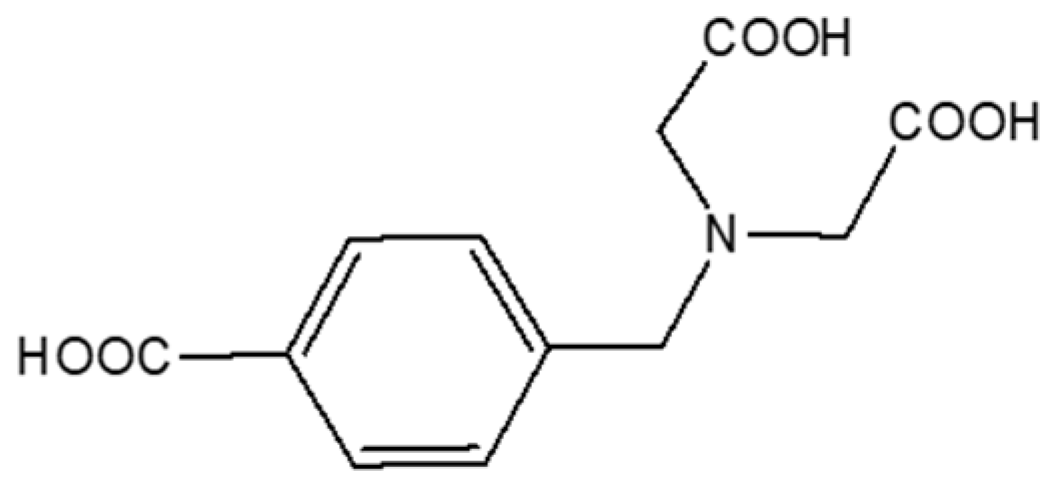
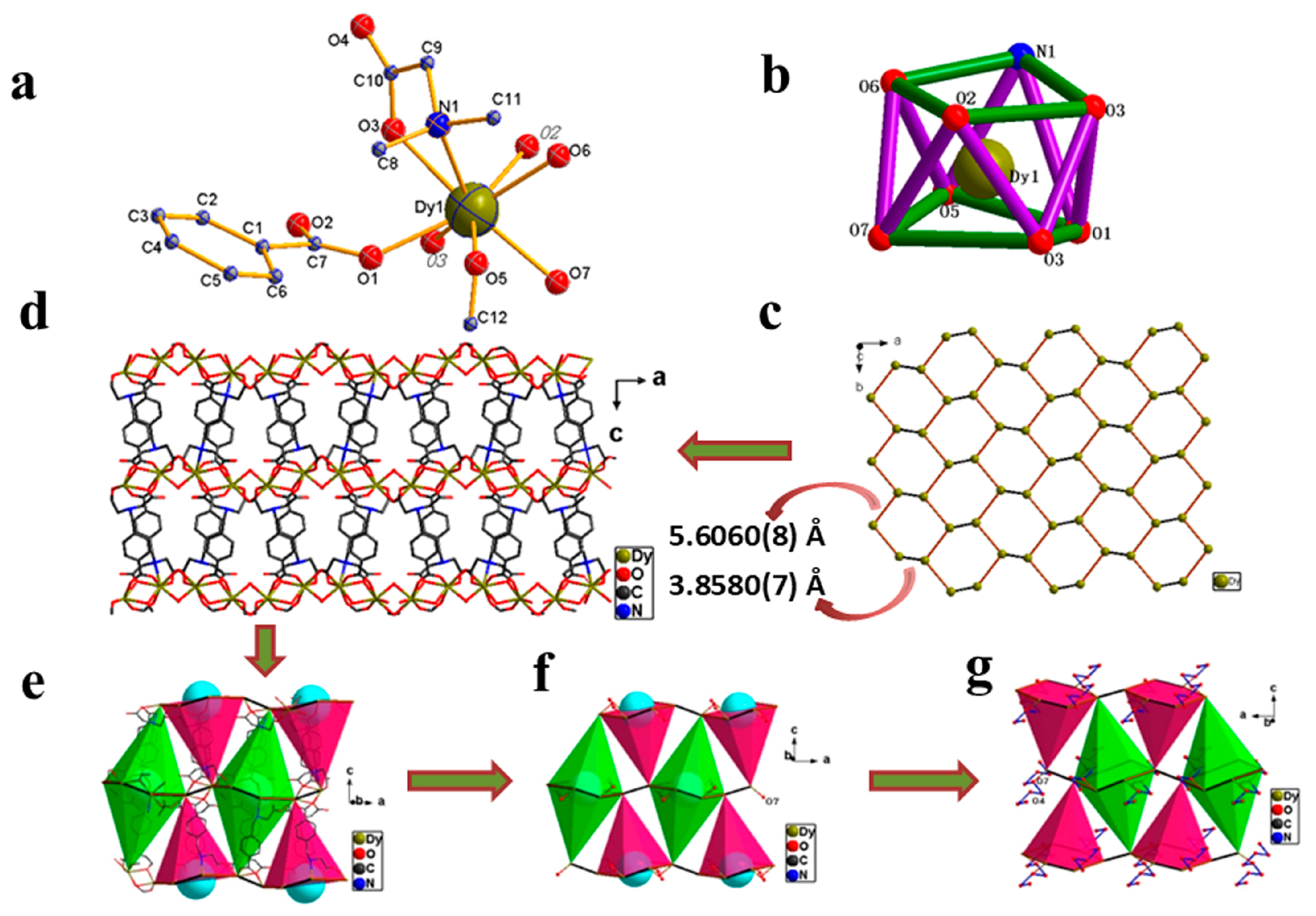
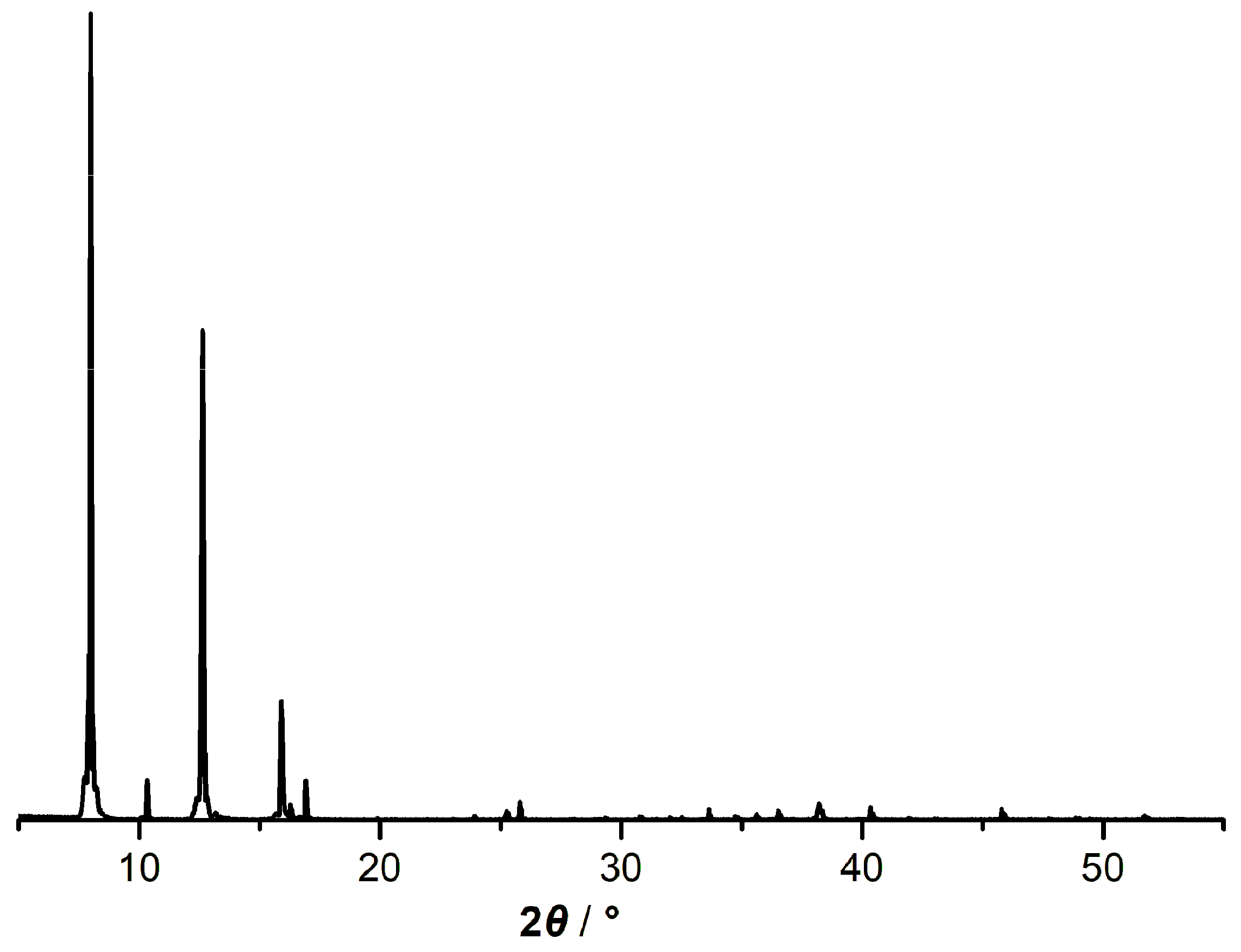
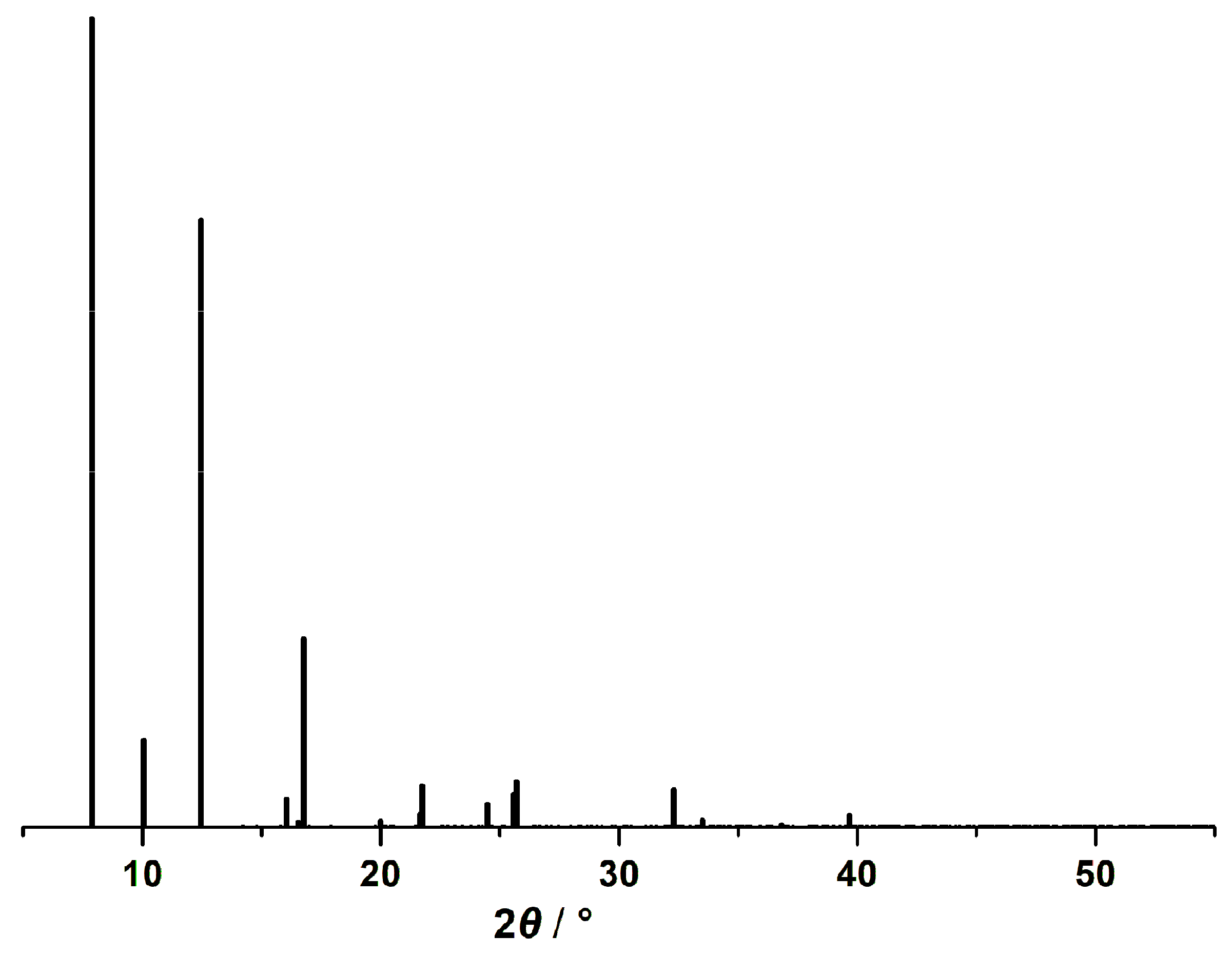
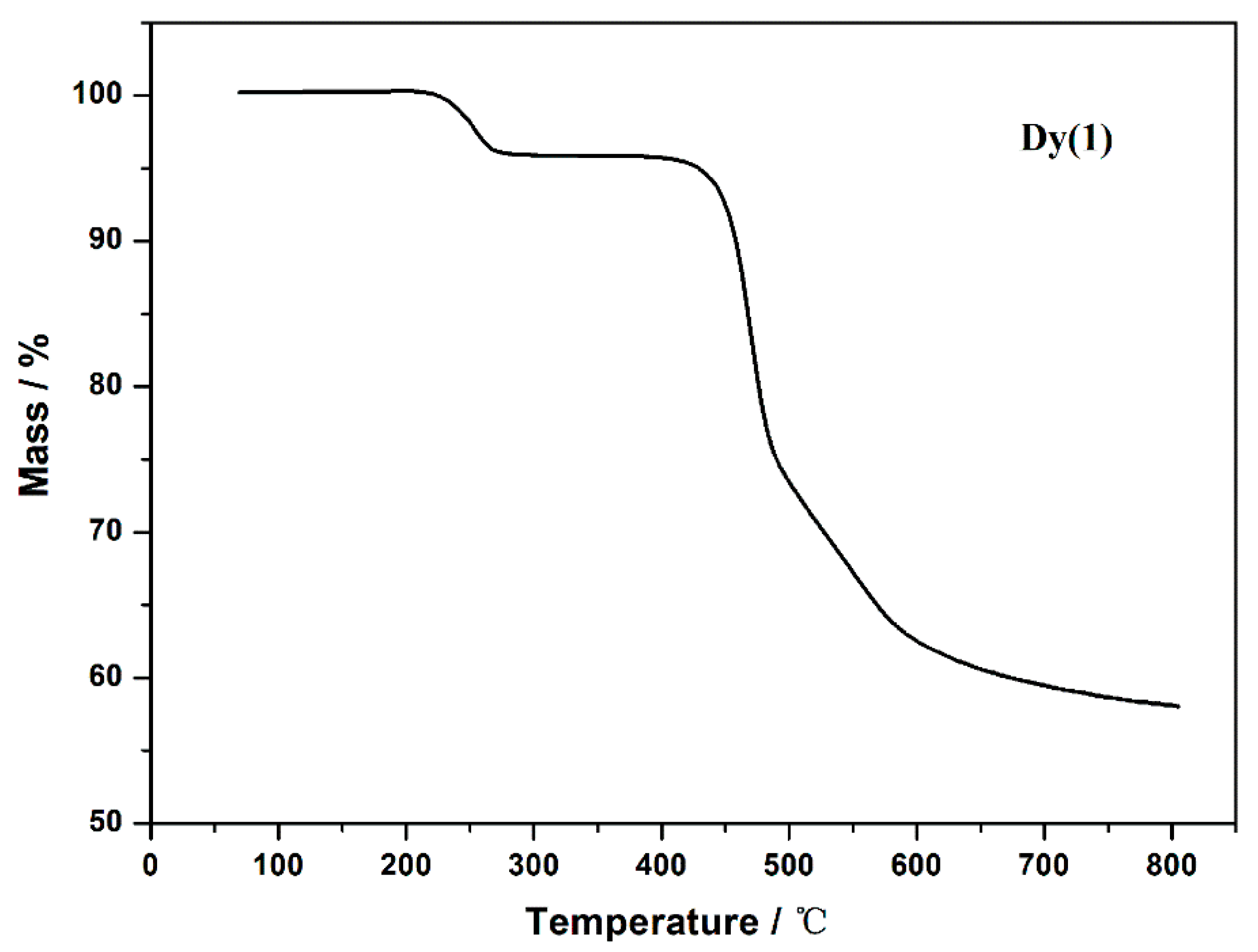
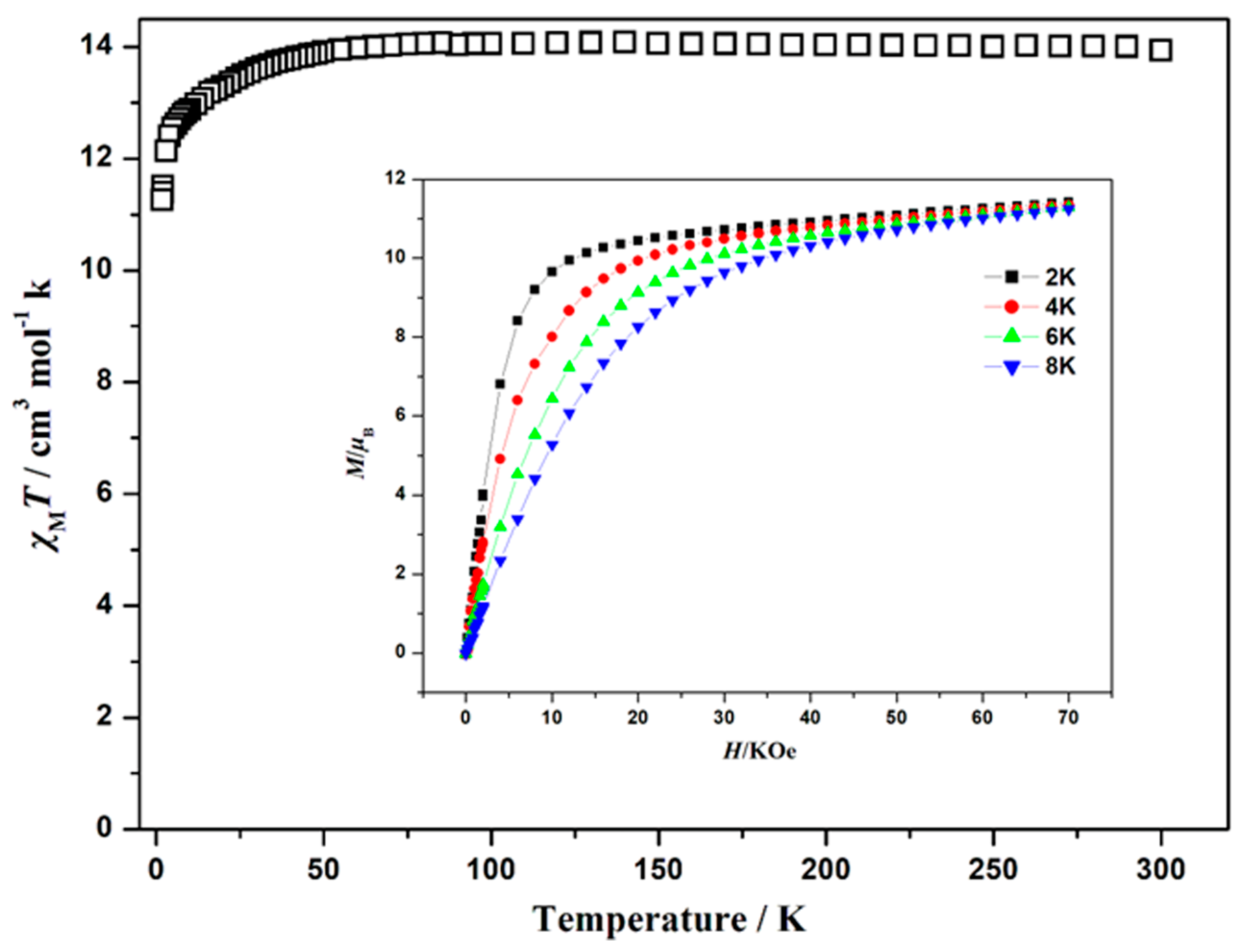


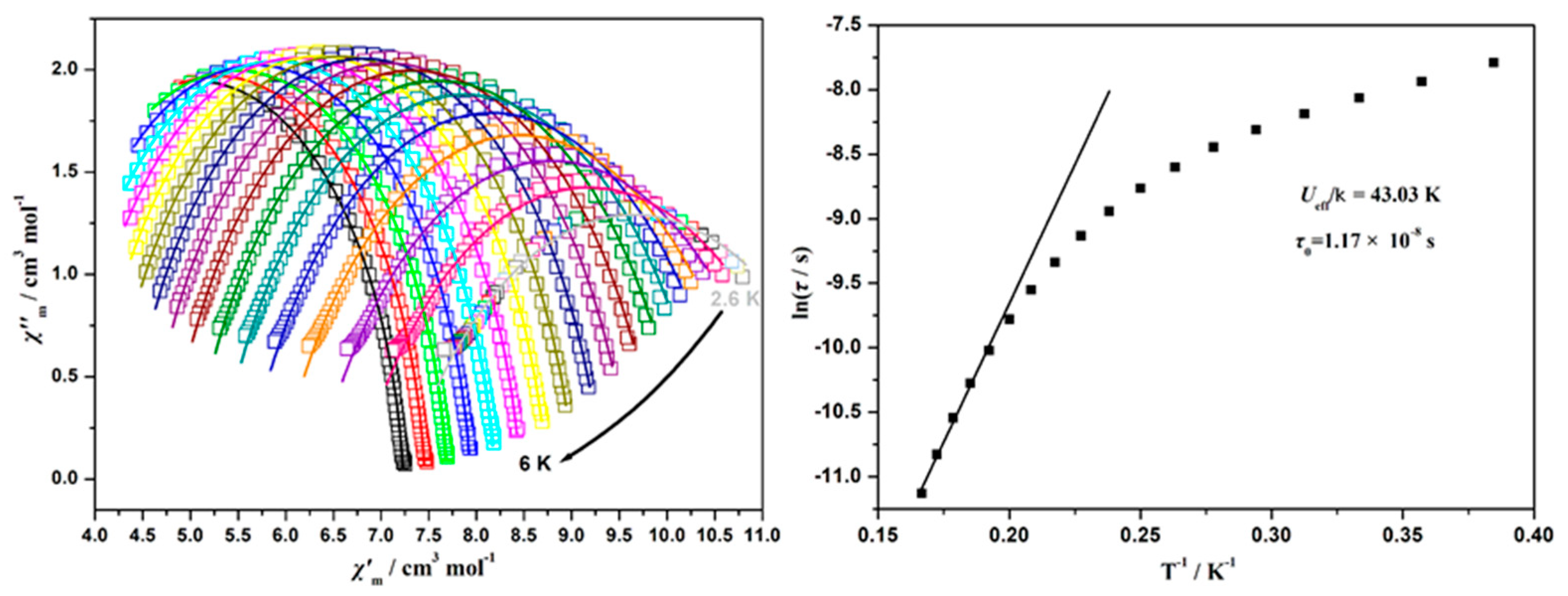
| Parameter | [DyLH2O]n (1) |
|---|---|
| Formula | C12H12NO7Dy |
| Formula weight | 444.73 |
| T [K] | 298(2) |
| Crystal system space group | Orthorhombic, Pbca |
| a [Å] | 14.1380(12) |
| b [Å] | 8.8120(6) |
| c [Å] | 22.416(2) |
| α [°] | 90 |
| β [°] | 90 |
| γ [°] | 90 |
| V [Å3] | 2792.6(4) |
| Z | 8 |
| ρcalc. [gcm−3] | 2.116 |
| µ [mm−1] | 5.384 |
| F(000) | 1704 |
| θ range [°] | 2.32 to 25.01 |
| Limiting indices | −16 ≤ h ≤ 15, −9 ≤ k ≤ 10, −26 ≤ l ≤ 25 |
| Reflections collected /unique | 12,364/2468 [Rint = 0.0326] |
| Data/ restraints/para. | 2468/0/190 |
| GoF | 1.055 |
| R1 wR2 [I > 2σ(I)] | 0.0220, 0.0493 |
| R1 wR2 (all data) | 0.0315, 0.0525 |
| Largest diff. peak and hole [e.A−3] | 0.716, −0.582 |
Disclaimer/Publisher’s Note: The statements, opinions and data contained in all publications are solely those of the individual author(s) and contributor(s) and not of MDPI and/or the editor(s). MDPI and/or the editor(s) disclaim responsibility for any injury to people or property resulting from any ideas, methods, instructions or products referred to in the content. |
© 2025 by the authors. Licensee MDPI, Basel, Switzerland. This article is an open access article distributed under the terms and conditions of the Creative Commons Attribution (CC BY) license (https://creativecommons.org/licenses/by/4.0/).
Share and Cite
Liu, M.; Meng, Z.; Wang, X.; Cui, Y. A Coordination Polymer of Dy(III) with Polycarboxylic Acid Ligand: Synthesis, Characterization and Magnetic Properties. Crystals 2025, 15, 550. https://doi.org/10.3390/cryst15060550
Liu M, Meng Z, Wang X, Cui Y. A Coordination Polymer of Dy(III) with Polycarboxylic Acid Ligand: Synthesis, Characterization and Magnetic Properties. Crystals. 2025; 15(6):550. https://doi.org/10.3390/cryst15060550
Chicago/Turabian StyleLiu, Mingli, Zhiyu Meng, Xinfang Wang, and Yanan Cui. 2025. "A Coordination Polymer of Dy(III) with Polycarboxylic Acid Ligand: Synthesis, Characterization and Magnetic Properties" Crystals 15, no. 6: 550. https://doi.org/10.3390/cryst15060550
APA StyleLiu, M., Meng, Z., Wang, X., & Cui, Y. (2025). A Coordination Polymer of Dy(III) with Polycarboxylic Acid Ligand: Synthesis, Characterization and Magnetic Properties. Crystals, 15(6), 550. https://doi.org/10.3390/cryst15060550





